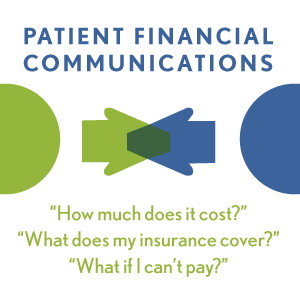
Money and health are two things most people don’t like to talk about. But if people and their doctors spoke more about health and finance, outcomes (both fiscal and physical) could improve.
In late October 2013, Best Practices for Communicating with Patients on Financial Matters were published by the Healthcare Financial Management Association (HFMA). Michael Leavitt, former head of the Department of Health and Human Services, led the year-long development effort on behalf of HFMA, with input from patient advocates, the American Hospital Association, America’s Health Insurance Plans, the American Academy of Family Physicians and the National Patient Advocate Foundation, along with former HHS Secretary Donna Shalala, former Senate Leaders and health experts Bill Frist and Tom Daschle, and Clinton Administration Deputy Attorney General Jamie Gorelick.
The best practices cover:
1. What happens inside of the emergency department (ED, ER) – for example, not engaging in a financial discussion until the patient is screened and stabilized, and making sure the patient receives in writing information about the provider’s financial assistance programs and a summary of the financial implications for the services rendered.
2. What happens outside of the ER – for example, upon registration, the provider should gather basic registration information including insurance coverage and determining the potential need for financial assistance, as well as review insurance eligibility details with the patient and inform uninsured patients about paying solutions and financial assistance options that may assist them in paying for the visit for which they’re registering.
3. What happens in advance of a health service (e.g., inpatient admission, surgical procedure) – for example, the provider should have clear definitions of what constitutes an elective vs. non-elective procedure. In registering the patient, the provider should have a clear policy on “how to interact” with patients with prior balances who are checking in to have a procedure. If this is an elective procedure as defined by the provider, the patients would be responsible for making payment arrangements before receiving care in order to receive that treatment. If the patient is registering for non-elective treatment, prior financial balances would not affect the provision of care.
4. What should happen across all settings – such as discussing financial issues with compassion, patient advocacy and educational support; using standard language by staff; trying to resolve these discussions face-to-face with patients; training staff on these best practices, financial assistance policies, common coverage solutions for the uninsured and underinsured, and customer service; and, making certain that communications are understandable by the patient, among other objectives.
5. How to measure success against these best practices, such as using updated technology for insurance verification, evaluating staff training programs, and providing feedback mechanisms for stakeholders to continue to improve patient financial communications processes.
Joe Fifer, head of HFMA, said in the organization’s press release, “Because patients are increasingly paying more of their healthcare costs out of their own pockets, clear communication between healthcare professionals and patients is becoming more important than ever. For this reason, the financial leaders of healthcare organizations should welcome these best practices.”
HFMA has been working on a Patient Friendly Billing project for several years, to help health providers better manage their revenue cycle.
Health Populi’s Hot Points: Talking about health costs openly, honestly, and transparently can bolster patient care – beyond the clinical. This dialog is an integral part of shared decision making and patient-centered health care.
HFMA will launch the Patient Financial Communications Adopter program in 2014 to recognize provider excellence in talking with patients about health costs and payment. Adopting these kinds of tactics could help hospitals and doctors achieve higher patient satisfaction scores – on which part of providers’ compensation will be based – but also increase payments and financial health of the institution.
For patients, greater transparency of cost and quality of service, before receiving those services, will translate into their feeling and being more financial accountable and empowered. If the patient is covered under a high-deductible health plan, for example, they can figure out in advance how to manage the cost of the service within the deductible, if they can use their health savings account to cover out-of-pocket charges, and whether to shop around for the service on a competitive basis.
This financial discussion is part of a larger consumer-health ecosystem that’s emerging online, to help drive greater transparency, choice and quality for health consumers in the growing consumer-driven health environment. For more on that phenomenon, see Help Yourself: The Rise of Online Health Marketplaces from California HealthCare Foundation.




 I'm in amazing company here with other #digitalhealth innovators, thinkers and doers. Thank you to Cristian Cortez Fernandez and Zallud for this recognition; I'm grateful.
I'm in amazing company here with other #digitalhealth innovators, thinkers and doers. Thank you to Cristian Cortez Fernandez and Zallud for this recognition; I'm grateful. Jane was named as a member of the AHIP 2024 Advisory Board, joining some valued colleagues to prepare for the challenges and opportunities facing health plans, systems, and other industry stakeholders.
Jane was named as a member of the AHIP 2024 Advisory Board, joining some valued colleagues to prepare for the challenges and opportunities facing health plans, systems, and other industry stakeholders.  Join Jane at AHIP's annual meeting in Las Vegas: I'll be speaking, moderating a panel, and providing thought leadership on health consumers and bolstering equity, empowerment, and self-care.
Join Jane at AHIP's annual meeting in Las Vegas: I'll be speaking, moderating a panel, and providing thought leadership on health consumers and bolstering equity, empowerment, and self-care.